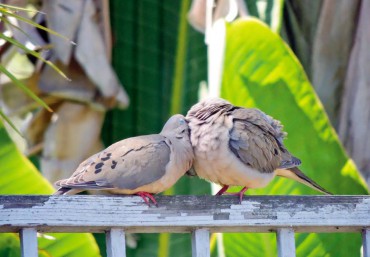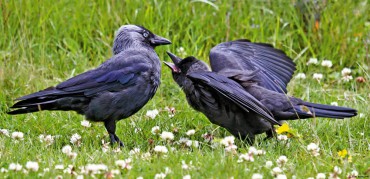
Birds have almost as many strategies as people do for getting together. Avian mating styles have been a topic of recent research and ornithologists now recognize how subtle and diverse bird partnerships really are.
Monogamy: The most typical type of partnership is monogamy, where one male and one female mate and stay together during the nesting season for the purpose of raising one or more broods of young. Some common North American birds that employ this strategy are the Carolina chickadee, Northern flicker and scarlet tanager.
In many monogamous birds, the pair bond may last for only one nesting, in others it may last for an entire breeding season. At the far end of the spectrum are birds like bald eagles and trumpeter swans, whose pair bonds endure year-round, year after year.
One of the biggest urban legends is that the majority of birds mate for life. The reality is that most pair bonds in birds simply don’t last very long and only about 14 percent of bird species form “’till death do us part” partnerships.
Advances in using DNA testing in bird research have led to the discovery that most monogamous birds engage in extra-pair mating with birds other than their own bonded mates.
The true bond for most monogamous birds is not a sexual bond, it is a social bond. A socially bonded pair will stay together on a common territory and raise their nestlings together but sexual fidelity is not part of the equation.
More than 90 percent of bird species are now believed to be socially monogamous, with “cheating” and extra-pair mating being much more the norm than previously recognized.
Polygamy: Polygamy is when one member of a bonded pair of birds openly maintains multiple partners. When a male bird is polygamous, it is called polygyny, which means that one male generally forms pair bonds with numerous females.
About 2 percent of the world’s birds commonly adopt this strategy. Common North American birds that are polygynous include the red-winged blackbird, house wren and yellow warbler.

In many polygyny species the males don’t participate much, if at all, in rearing the young, although they may defend a feeding territory that the females use. As a result, polygyny is most common among species nesting in environments where the females can find adequate food for the young close to the nest (such as grasslands and marshes) or in which the young can walk and feed themselves almost from birth like many grouse and shorebirds.
When a female bird is polygamous, it is called polyandry and it means that one female forms pair bonds with several males. Less than 1 percent of birds do this and almost all of them are rails and shorebirds such as the spotted sandpiper.
In these species, typical sex roles are largely reversed. The females are bigger, more colorful and showier than the males, and they perform courting displays to compete for partners. They even defend breeding territories against other females.
In most polyandrous species, the female lays eggs in several nests and different males take responsibility for incubating and raising the young. This leaves the female free to attract other mates.
Promiscuity: In promiscuous species, each female may mate with many males and each male can mate with multiple females. Promiscuous birds do not form any type of pair bond and anything goes as for who mates with whom.
All the hummingbirds of North America are promiscuous, as are about 6 percent of the world’s birds. Among promiscuous birds, the females almost always raise the young alone.
Courtship behavior: Before a bond can be formed, birds typically perform courtship rituals to make sure they are selecting the best possible mate. There are many different types of these rituals and understanding some of the basic courtship behaviors can help you better appreciate the bird relationships that are occurring in your backyard.
Preening: Preening behavior between male and female birds can be part of the courtship rituals to help diffuse their normal territorial boundaries and aggression. The birds may lightly preen one another, sit with their bodies touching or otherwise lean on one another to show that they are not intending to harm their partner.
Singing: Singing is one of the most common ways birds can attract a mate. The intricacy of the song or the variety of different songs one bird can produce helps to advertise its maturity and intelligence — desirable characteristics for a healthy mate.
Singing can also broadcast the boundaries of one bird’s territory, warning off competition. For some species, only one gender (most usually the males) will sing, while other species may create a duet as part of the bonding ritual.
Displays: Flamboyant plumage colors and elaborate displays of prominent feathers, skin sacs or body shape can show off how strong and healthy a bird is, advertising its suitability as a mate.
Hummingbirds are one of the best-known bird species for their stunning display of the males’ iridescent gorget, while male red-winged blackbirds are known to selectively display their bright-red wing patches when defending their territory.
Feeding: Sharing food is a common part of the bird courtship behavior for many species. A male bird may bring a morsel to the female, demonstrating that he is able not only to find food but that he can share it and is able to provide for her while she incubates eggs or tends the young.
For some species, the male may simply provide food for the female to eat, while in other species he will actually place a seed or insect directly in her mouth just as he might be expected to do when helping feed hungry nestlings.
Dancing: The dancing courtship rituals in birds can take many forms, such as wing flaps, head dips and intricate footwork. In many species, the male alone will dance for his female while she observes his actions, while in other species both partners will interact with one another. Dance mistakes show inexperience or hesitancy and would likely not lead to a successful mating.
Nest building: Some birds seek to attract a mate by showing off their building skills. Constructing nests before the female arrives is a way for males to claim territory and show the suitable nesting areas they can defend. They may also decorate the nest with pebbles, moss, flowers or even litter to make it more eye-catching. The female may then choose the nest she prefers or she may still build her own after mating with her chosen male.





























